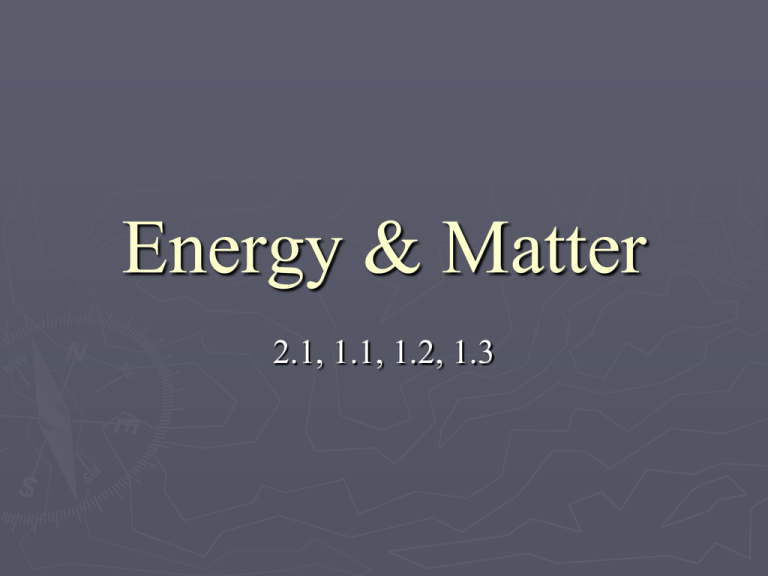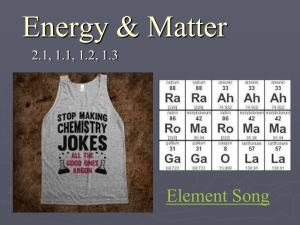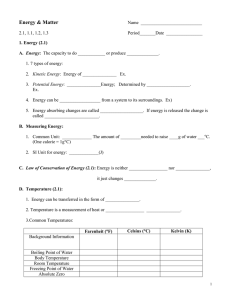Energy & Matter 2.1, 1.1, 1.2, 1.3
advertisement

Energy & Matter 2.1, 1.1, 1.2, 1.3 1. Energy (2.1) A. Energy: The capacity to do work or produce heat. 1. 7 types of energy: • mechanical • thermal (heat) • radiant (light) • sound • electrical • chemical • nuclear 2. Kinetic Energy: Energy of motion. Ex. thermal, mechanical 3. Potential Energy: stored energy; determined by position. Ex. Electrical PE, chemical PE Potential and Kinetic Energy 4. Energy can be transferred from a system to its surroundings. Ex. Photosynthesis is light → chemical Energy Transformations: 5. Energy absorbing changes are called endothermic. If energy is released the change is called exothermic. B. Measuring Energy: 1. Common Unit: calorie The amount of heat needed to raise 1 g of water 1 oC. (One calorie = 1g°C) 2. SI Unit for energy: Joule (J) C. Law of Conservation of Energy: Energy is neither created nor destroyed, it just changes form. Temperature (2.1): 1. Energy can be transferred in the form of heat. 2. Temperature is a measurement of heat or kinetic energy. (how fast the average particle is moving!) Heat vs. Temperature Animation Kinetic Energy (Temperature) and Melting 3. Common Temperatures Fahrenheit (F) Celsius (°C) Kelvin (K) Background Information Popular (1686-1736) scientists (1701-1744) SI Unit Absolute scale (1824-1907) Boiling Point of Water 212 100 373 Body Temperature 98.6 37 310 Room Temperature 70 20 293 Freezing Point of Water 32 0 273 Absolute Zero -459.67 -273 0 98.6°F Room Temp 70°F → Room Temp 20°C → ← Room Temp 293 K 4. Kelvin: °C = K K = °C + 273 °C = K - 273 5. The zero point on the Kelvin scale is called absolute zero (-273°C) 6. All motion of particles stops! Therefore the kinetic energy is zero. 2. Matter is anything that has mass and takes up space. 1. Volume: Amount of space an object takes up. 2. Mass: Quantity of matter in a substance. Constant everywhere. Ex) the moon 3. Weight: Force produced by gravity acting on a mass. This is different in different locations. Mass Vs. Weight Mass does not depend on gravity. The mass of an object remains the same in all locations. Weight and Mass Demo Weight depends on gravity. Weight equals Mass x gravity. The weight of an object changes with location. B. Properties of Matter (1.2): 1. Physical: density, color, melting point, viscosity, surface tension, specific heat 2. Chemical: flammability, reactivity with other chemicals or air (O2) C. States of Matter (1.1): State Shape Volume Movement Structure Solid definite definite vibrational - slow highly organized - crystal Liquid indefinite definite translational - medium medium - fluid translational - fast low - random Gas indefinite indefinite Plasma is the 4th state of matter – “ionized gas” like the sun D. Kinetic Theory of Matter (2.1) 1. Gases possess the greatest amount of kinetic energy. 2. Two factors that determine the state of matter of a substance: speed of the particles and the distance between them. 3. These two factors contribute to the attraction between the particles. 4. Substances change phase when they overcome these attractions. 5. The overall kinetic energy (temperature) will remain constant until the entire substance has completely changed phase. 6. Heating Curve for Water condensation 100 Vaporization Liquid freezing 0 (C) Solid melting (boiling/evaporation) Vapor (gas) E. Changes in Matter (2.1): 1. Physical Changes: a. Do NOT change the identity of the substance. b. Often change what the substance looks like. c. Examples: cutting, dyeing, changes of state States of Matter & Phase Changes Solid condensation vaporization Liquid evaporation –at the surface boiling - throughout Gas (Vapor) States of Matter Comparison of the three states of matter Density = 1.00g/mL Density = .92g/mL 2. Chemical Changes: a. Alter the identity of the substance. b. The new substance has different properties than the original substance. c. Examples of Chemical Changes: burning, rusting d. Signs that a chemical change has occurred: 1. gas released (bubbles/odor/fizz/smoke) 2. color change (can be physical too) 3. formation of a precipitate (insoluble solid that falls out of solution.) 4. temperature change (can be physical also) F. Law of Conservation of Matter (2.2): Matter is neither created or destroyed it just changes form. G. Classification of Matter (1.3) 1. Pure substances: Substances that have a unique set of physical and chemical properties. a. Elements: The smallest part of an element is an atom. 1. Cannot be separated into simpler substances. 2. Represented by symbols that have 1 or 2 letters. Ex) K, Na, Au, Ag, Hg, Fe (three lettered symbols are temporary) 3. Examples: 1 Atomic Number: # of protons Element Symbol: 1 or 2 letters (1st is a capital) H Hydrogen Element Name 1.008 Atomic Mass: (weighted average of all an elements’s isotopes) b. Compounds: 1. Made up of 2 or more kinds of atoms chemically combined in a fixed proportion. 2. Represented by formulas. 3. Examples: CO, CO2, H2O 2. Mixtures: a. Heterogeneous Mixture: Visibly different throughout. Will separate upon standing. Ex) salad dressing (emulsion), chocolate chip cookies, sand & water (suspension) b. Homogeneous Mixture: The same throughout. May be clear, will not separate. Ex) Kool-aid (solution) milk (colloid) gold jewelry (alloy) Examples of Alloys Brass is an alloy of copper and zinc. Steel is an alloy of carbon and iron. Bronze is an alloy of copper and tin. Gold – Element & Alloys Microscopic look at mixtures Suspensions Colloids Solutions ex) sand & water ex) milk ex) Kool-Aid Alloys ex) gold jewelry H. Separating Mixtures (1.3) 1. Heterogeneous Mixtures can be separated by: a. FiltrationMaterial remaining on the filter paper is called the residue. The filtrate goes through the filter paper. Ex) sand & water Separation of Homogeneous Mixtures: a. Distillationseparates liquids (and 1 solid) by differences in boiling point. The remaining material is called the residue. The material that goes through is called the distillate. Ex) alcohol & H2O Another Look at Distillation • Distillation Demo • A Closer Look at Distillation Separation of Homogeneous Mixtures b. Crystallization- Evaporate liquid and the solid will crystallize. Ex) salt and water c. Chromatography – used to separate pigments and ink by differences in solubility (density) on a strip of paper. Ex) black ink - rainbow Another look at Paper Chromatography 3. Separating Compounds: a. Electrolysis – decomposes a compound into its elements. Ex) water into H2 and O2



